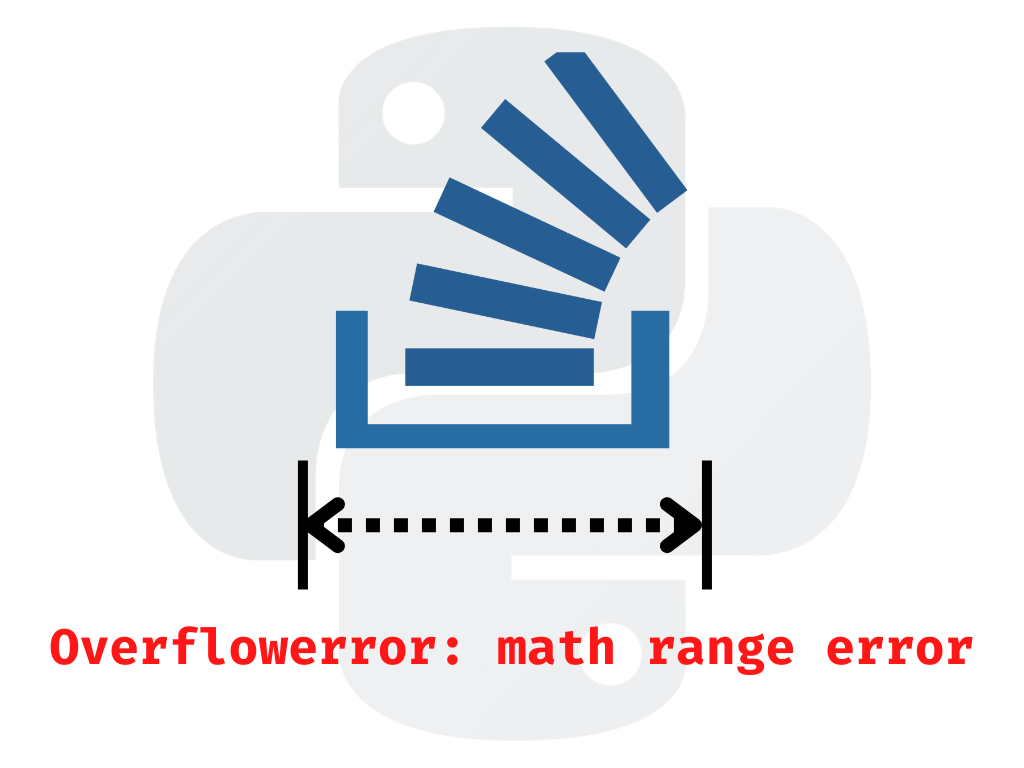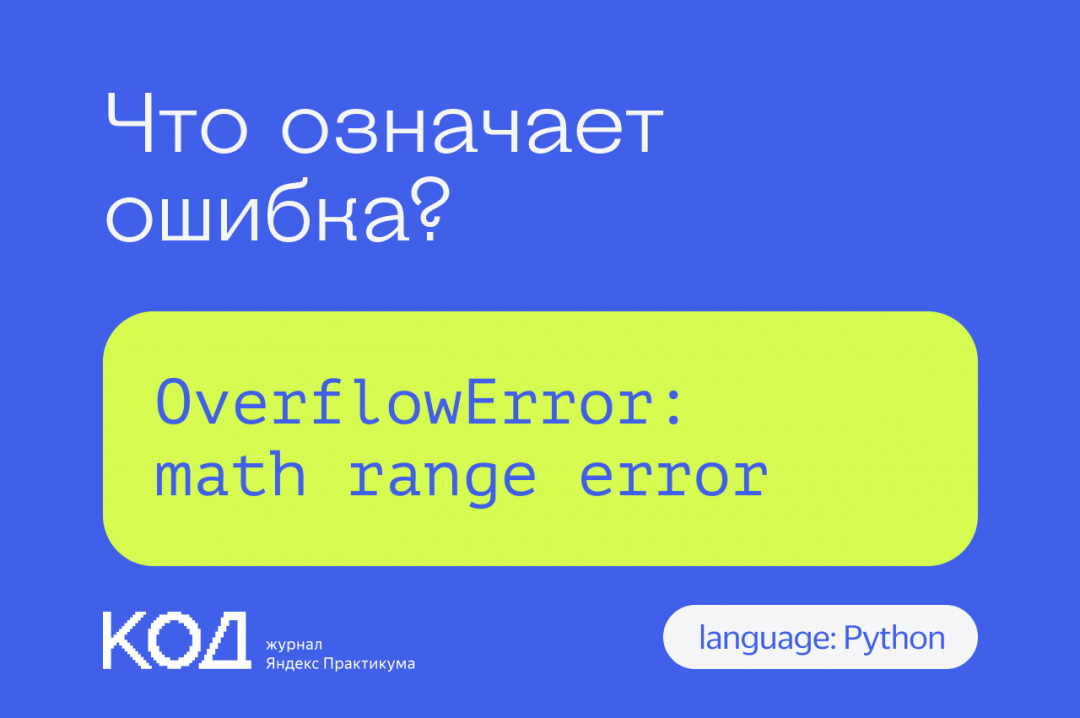A programmer in Python encounters many errors, one of which is ‘overflowerror: math range error.’ This error happens because any variable which acts as an operand and holds data in any form has a maximum limit to store the data. Thus, when the program written by the programmer tries to exceed those limits in any arithmetic or mathematical or any other operation, we get ‘overflowerror: math range error’. Nevertheless, there are ways you can deal with this error, and we will discuss those ways in this article.
Let us see an example of ‘overflowerror: math range error’ to understand how this error occurs. We will take an example in which we write a simple code for carrying out the calculation of exponential value.
import math
x = int(input("Enter value of x: "))
y = math.exp(x)
print(y)
Output:
Enter value of x: 2000
Traceback (most recent call last):
File "C:testcode.py", line 3, in <module>
y = math.exp(x)
OverflowError: math range error
As you can see from the above example, we have declared a variable ‘x’ and assigned a value to it by taking user input. Further, we use this variable as the exponential power. Although the value computed in this case is way more than a variable can hold, the data type limit is 709, and we have exceeded the limit by taking 2000. Therefore this code throws an ‘overflowerror: math range error’. So now we have seen how this error occurs. Further, let’s see how you can solve this kind of error.
Using Try/Except To Solve Overflowerror: Math Range Error
‘Overflowerror: math range error’ is an exception type of error and we can use try/except to handle this exception. Exception type of errors arises after passing our code syntax, or basically, we can say exception errors occur during runtime. ‘Try’ and ‘except’ allows us to handle exceptions in our code. ‘Try’ and ‘except’ is somehow similar to ‘if’ and ‘else’ in some way, but it instead checks if an exception arises in the code and executes the code accordingly. Further if no exception arises, the ‘try’ clause is executed, and if exceptions arise ‘except’ clause is executed.
So eventually, we can use ‘try’ and ‘except’ to solve this error, to understand how to let us know with the help of an example.
import math
x = int(input("Enter value of x: "))
try:
y = math.exp(x)
except OverflowError:
y = float('inf')
print("x value should not exceed 709")
print(y)
Output:
Enter value of x: 2000 x value should not exceed 709 inf
In the above example, we have written the same code which carries out exponential calculations. Although in this code, there is no error thrown because of the ‘try’ and ‘except’ clauses. The ‘try’ clause checks if the code raises any exception after we enter the value of ‘x’ as 2000. The data type limit is 709. Therefore, an exception will arise, and the ‘except’ clause will execute.
Using Numpy Library
The numpy library in Python is vastly used when dealing with mathematical data and programs. Numpy library does not raise an exception when a program tries to operate at a capacity exceeding the data-type limit. Therefore we can use numpy to execute our code without throwing an error.
import numpy as np
x = int(input("Enter value of x: "))
y = np.exp(x)
print(y)
Output:
Enter value of x: 2000 inf
From the code output, you can see that numpy gives ‘inf’ as output without raising an exception. It only raises a warning during runtime but executes code without error.
Using If/else For Solving Overflowerror: Math Range Error
You can also use ‘if’ and ‘else’ statements to check if your code will raise an exception beforehand the exception raises. When we use the if/else statement to solve this error, we are not letting the exception be raised by setting up a loop that checks if the value exceeds the data-type limit and only executes the mathematical operator if it is not. Let us make it more clear to understand using an example.
import math
x = int(input("Enter value of x: "))
if (x < 709)
y = math.exp(x)
print(y)
else
print("x value should not exceed 709")
Output:
Enter value of x: 2000 x value should not exceed 709
From the example code, you can see when we enter the value of ‘x’ in input, the ‘if’ statement checks if it is less than 709. Thus it only executes the if statement and calculates the exponential value if the value of ‘x’ is less than 709. However, it prints “x value should not exceed 709” if the value is greater than 709. Therefore you can see that we only execute the mathematical operation after checking the criteria that signify if the program will raise an exception or not.
Solving Overflowerror In ‘Math.pow()’ Function
This error can also occur when we are using the ‘math.pow()’ function. ‘pow()’ function allows you to carry out exponential calculations, it takes two variables as arguments where one is the base variable, and the other is exponential variable. Therefore this function can throw ‘overflowerror: math range error’ if the exponential variable is much greater and the calculation results in exceeding the data-type limit.
import math
x = int(input("Enter the base variable: "))
y = int(input("Enter the exponential variable: "))
calculation = math.pow(x, y)
print(calculation)
Output:
Enter the base variable: 3
Enter the exponential variable: 1000
File "C:testcodetwo.py", line 3, in <module>
calculation = math.pow(x, y)
OverflowError: math range error
As you can see from the example code above, if the exponential variable is much more significant and the calculation exceeds the data-type limit, it raises an exception. You can solve this error by using any of the methods discussed earlier in this article, for example:
import math
x = int(input("Enter the base variable: "))
y = int(input("Enter the exponential variable: "))
try:
calculation = math.pow(x, y)
except OverflowError:
calculation = float('inf')
print("base variable value should not exceed 709")
print(calculation)
How To Avoid Overflow Errors?
So far in the article, we have seen how you can handle the ‘overflow error,’ but it is far better to avoid errors in your program if possible to ensure smooth and desired execution. To prevent overflow errors, you need to keep these points in your mind:
- Be aware of the mathematical and arithmetic operator’s input data-type limits.
- Have a general idea about the calculations and their sizes to be performed in the code so you can avoid raising an error.
- Use operators who are suitable and capable of handling your calculations efficiently.
FAQs
What is overflowerror: math range error?
It is an exception type of error that arises when the mathematical or arithmetic operations in your code exceed the data-type limit.
How can you solve overflowerror: math range error?
You can solve this error by using various methods discussed in this article, for example, by using try/except or by using the numpy library.
How does Python handle overflow errors?
Overflow error is an exception type of error. Therefore, you can use ‘exception handling’ methods in Python to handle this kind of error.
Conclusion
Finally, we have seen various ways to solve ‘overflowerror: math range error’ in Python. You can use any of the methods which you desire or that your code permits you to use. However, it is best to avoid errors when writing a code because error-free code always provides the best results.
To know more about other ‘OverflowError: Python int too large to convert to C long’ type of error and how to solve it, check this post.
Trending Python Articles
-
“Other Commands Don’t Work After on_message” in Discord Bots
●February 5, 2023
-
Botocore.Exceptions.NoCredentialsError: Unable to Locate Credentials
by Rahul Kumar Yadav●February 5, 2023
-
[Resolved] NameError: Name _mysql is Not Defined
by Rahul Kumar Yadav●February 5, 2023
-
Best Ways to Implement Regex New Line in Python
by Rahul Kumar Yadav●February 5, 2023
Что означает ошибка OverflowError: math range error
Это ошибка переполнения из-за математических операций
Это ошибка переполнения из-за математических операций
Ситуация: для научной диссертации по логарифмам мы пишем модуль, который будет возводить в разные степени число Эйлера — число e, которое примерно равно 2,71828. Для этого мы подключаем модуль math, где есть нужная нам команда — math.exp(), которая возводит это число в указанную степень.
Нам нужно выяснить различные значения числа в степени от 1 до 1000, чтобы потом построить график, поэтому пишем такой простой модуль:
# импортируем математический модуль
import math
# список с результатами
results = []
# перебираем числа от 1 до 1000
for i in range(1000):
# добавляем результат в список
results.append(math.exp(i))
# и выводим его на экран
print(results[i-1])Но при запуске кода компьютер выдаёт ошибку:
❌ OverflowError: math range error
Что это значит: компьютер во время расчётов вылез за допустимые границы переменной — ему нужно записать в неё большее значение, чем то, на которое она рассчитана.
Когда встречается: во время математических расчётов, которые приводят к переполнению выделенной для переменной памяти. При этом общий размер оперативной памяти вообще не важен — имеет значение только то, сколько байт компьютер выделил для хранения нашего конкретного значения. Если у вас, например, 32 Гб оперативной памяти, это не поможет решить проблему.
Что делать с ошибкой OverflowError: math range error
Так как это ошибка переполнения, то самая частая причина этой ошибки — попросить компьютер посчитать что-то слишком большое.
Чтобы исправить ошибку OverflowError: math range error, есть два пути — использовать разные трюки или специальные библиотеки для вычисления больших чисел или уменьшить сами вычисления. Про первый путь поговорим в отдельной статье, а пока сделаем проще: уменьшим диапазон с 1000 до 100 чисел — этого тоже хватит для построения графика:
# импортируем математический модуль
import math
# список с результатами
results = []
# перебираем числа от 1 до 100
for i in range(100):
# добавляем результат в список
results.append(math.exp(i))
# и выводим его на экран
print(results[i-1])Вёрстка:
Кирилл Климентьев
Получите ИТ-профессию
В «Яндекс Практикуме» можно стать разработчиком, тестировщиком, аналитиком и менеджером цифровых продуктов. Первая часть обучения всегда бесплатная, чтобы попробовать и найти то, что вам по душе. Дальше — программы трудоустройства.
Начать карьеру в ИТ

The OverflowError: math range error is a built-in Python exception raised when a math range exceeds its limit. There is a limit for storing values for every data type in Python. We can store numbers up to that limit. If the number exceeds the maximum limit, then the OverflowError is raised.
To solve OverflowError: math range error in Python, fit the data within the maximum limit. We must use different data types to store the value if this data cannot be fitted. When the data limit is exceeded, then it is called the overflow.
import math
ans = math.exp(1)
print(ans)Output
The output is printed as 2.718281828459045. This program is used for calculating the exponential value.
import math
ans = math.exp(900)
print(ans)Output
OverflowError: math range errorIt raises an error called the OverFlowError because the exponential value would have exceeded the data type limit.
To solve OverflowError programmatically, use the if-else statement in Python. We can create an if condition for checking if the value is lesser than 100. If the value is less than 100, it will produce an exponential value. And in the else block, we can keep a print statement like the value is too large for calculating the exponentials.
import math
num = 2000
if(num < 100):
ans = math.exp(num)
print(ans)
else:
print("The value is too large, Please check the value")Output
The value is too large, Please check the valueUsing the if-else statement, we can prevent the code from raising an OverflowError. 100 is not the end limit. It can calculate around 700, but running takes a lot of memory.
One more way to solve this problem is by using try and except block. Then, we can calculate the exponent value inside the try block. Then, the exponent value is displayed if the value is less than the data limit.
If the value exceeds the limit, then except block is executed. OverflowError class name can be used to catch OverflowError.
import math
val = int(input("Enter a number: "))
try:
ans = math.exp(val)
print(ans)
except OverflowError:
print("Overflow Error has occurred !")Output
Enter a number: 1000
Overflow Error has occurred !In this program, if we give a value less than 700 or 500, this program works well and generates the output. However, if the value is equal to or greater than 1000, the error message will be displayed as output. We used the try and except block to solve this OverflowError.
Conclusion
The OverflowError is raised when the value is greater than the maximum data limit. The OverflowError can be handled by using the try-except block. If and else statement can be used in some cases to prevent this error.
That’s it for this tutorial.
Related posts
How to Solve OverflowError: Python int too large to convert to C long
How to Solve ArithmeticError Exception in Python
How to Solve IndexError: list index out of range in Python
Krunal Lathiya is a Software Engineer with over eight years of experience. He has developed a strong foundation in computer science principles and a passion for problem-solving. In addition, Krunal has excellent knowledge of Data Science and Machine Learning, and he is an expert in R Language. Krunal has experience with various programming languages and technologies, including PHP, Python, and JavaScript. He is comfortable working in front-end and back-end development.
In mathematical calculation, if the value reaches the allowed data type limit in the python, the exception “OverflowError: math range error” is thrown away. We’ll see the specifics of this “OverflowError” error in this article.
In python, the maximum limit is set for each data type. The value should be within the data type limit when performing any mathematical operations. If the value is greater then the data type would not be able to handle the value. In this case, python creates an error stating that the value exceeds the permissible limit.
The developer should be taking the proper action on the interest in this situation. We’ll see how to handle that situation in this post. We discus all possible solutions to this error.
Traceback (most recent call last):
File "D:pythonexample.py", line 2, in <module>
answer=math.exp(1000)
OverflowError: math range error
>>>Root Cause
Python makes use of the operands when running the mathematical operations. The operands are the variable of any one of the python data types. The variable can store the declared data types to their maximum limit.
If the program tries to store the value more than the maximum limit permitted for the data type, then python may trigger an error stating that the allowed limit is overflowing.
How to reproduce this issue
This problem can be replicated in the python math operation called exp. This task is to find the exponential power solution for the value. The data type limit allowed is 709.78271. If the program simulates to generate a value greater than the permissible limit, the python program will show the error.
pythonexample.py
import math
answer=math.exp(1000)
print(answer)Output
Traceback (most recent call last):
File "D:pythonexample.py", line 2, in <module>
answer=math.exp(1000)
OverflowError: math range error
>>>Solution 1
As discussed earlier, the value should not exceed permissible data type maximum limit. Find the exponential value with less will solve the problem. A if condition is applied to verify the input value before the exponential operation is completed. If the input value is higher, the caller will be shown the correct error message.
The code below illustrates how the exponential function can be used without throwing an error into the program.
pythonexample.py
import math
val = 1000
if val<50:
answer=math.exp(val)
print(answer)
else:
print("Input value is greater than allowed limit")Output
Input value is greater than allowed limit
>>>Solution 2
If the input value is not reliable, the other way this error can be treated is by using the form of try-except. Add the corresponding code to the try block. If the error happens then catch the error and take the alternative decision to proceed.
This way, this overflow exception will be handled in the code. The code below shows how to handle the overflow error in the python program using try and except.
pythonexample.py
import math
try:
answer=math.exp(1000)
except OverflowError:
answer = float('inf')
print(answer)Output
inf
>>>While working with any mathematical operation in Python, getting the “Overflow: math range error” is widespread. Whenever you encounter any such error message, it simply means that you have exceeded the data type limit.
The limit is present for each data type in Python. Whatever calculations you perform, your value should always be within this limit if you do not want to encounter the “Overflow: math range error.
In this article, we will cover what you can do if you face the “overflow: math range” error.
Also read: Pip command not found: 4 Fixes
Let’s see an example to understand the “OverflowError: Math range error” more clearly.
#The method exp() calculates E raised to the power of x, where the value of 'E' is approximately 2.7182, and 'x' is provided by the user as an input.
import math
print("Output when x = 709 is: ")
result=math.exp(709)
print(result)
print("nOutput when x = 709.78 is: ")
result=math.exp(709.78)
print(result)
print("nOutput when x = 709.79 is: ")
result=math.exp(709.79)
print(result)The exp() method of math library gives an error if the value of x exceeds 709.78 approximately. The output of the above code is shown below.
As you can see in the output, as soon as the value exceeded 709.78, the “OverflowError: math range error” was thrown. This happened because the value generated by math.exp(709.79) was more than the limit of the data type of variable result — double.
Since we have understood the OverflowError: Math range error clearly, let’s see how we can solve it.
How to solve the “OverflowError: Math range error”
You can fix the “OverflowError: math range error” by using the solutions mentioned below.
Using the try-except block
The exception handling of python can be used to fix the “OverflowError: math range error”. Put your exp() function inside the try block and while catching the error, put a print statement where you display the message to the user. See the code written below for better understanding.
import math
print("The value of 'x' is 711.")
x=711
try:
result=math.exp(x)
print(result)
except OverflowError:
print("nThe value of 'x' should not exceed 709.78.")
print("inf")
print("nHave a good day!n")The output of the above code is shown below.
Using the if-else block
You can check the value of ‘x’ provided by the user before passing it into the exp() function. If the value exceeds 709.78, you can print ‘inf’ where inf means infinite output.
import math
print("The value of 'x' is 711.")
x=711
if (x<709):
result=math.exp(x)
print(result)
else:
print("nThe value of 'x' should not exceed 709.78.")
print("inf")
print("nHave a good day!n")The screenshot attached below shows the output of the above code.
Using the exp() method of numpy library
You can use the exp() function of the numpy library to fix the Overflow error. If the value of x exceeds 709.78, the numpy gives a warning and shows infinity as output, due to which the program doesn’t halt.
import math
import numpy as np
print("nOutput when x = 709.78 is: ")
result=math.exp(709.78)
print(result)
print("nOutput when x = 709.79 is: ")
result=np.exp(709.79)
print(result)
print("nHave a good day!n")The output of the code written above is given below.
Also read: Is Python case sensitive when dealing with identifiers?
An avid reader and an engineering student. Love to code and read books. Always curious to learn new things 🙂



![[Resolved] NameError: Name _mysql is Not Defined](https://www.pythonpool.com/wp-content/uploads/2023/01/nameerror-name-_mysql-is-not-defined-300x157.webp)












